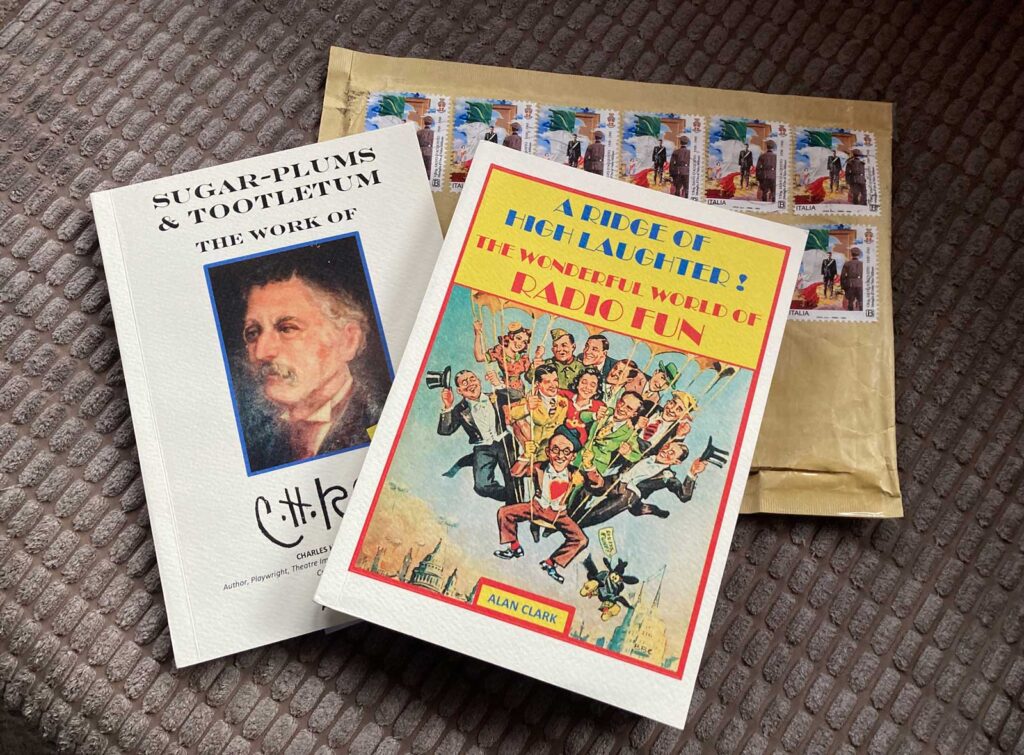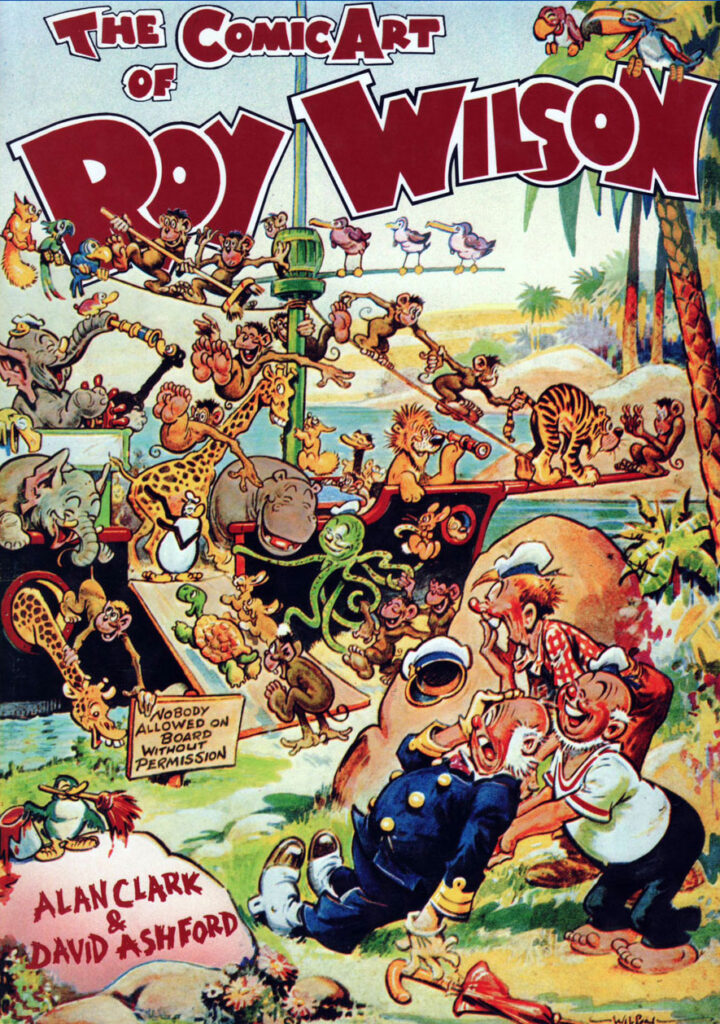
It’s always a joy for me when a letter from Italy drops through the letterbox covered in stamps, because I just know it’s from redoubtable British comic researcher Alan Clark, containing another of his enjoyable, highly recommended books.
Recently, I received not one, but two such packages, containing his latest, limited run, not-for-profit, and usually very quickly sold out tomes – the first, the entirely new A Ridge of High Laughter – The Wonderful World of Radio Fun, a glorious 300-page A5 book about the weekly comic, published by Amalgamated Press between 1938 and 1961, when it was merged into Buster. The other, an updated version of the previously-published Sugar-Plums & Tootletum, devoted to the lesser-known works of comics pioneer C.H. Cross, creator of Ally Sloper.
Radio Fun holds a special resonance for me, not because it’s a title I read (I’m not that old, contrary to belief!), but because I know it was a comic my late mother read as a child, her father the owner of a radio and TV repair shop in Fowey, Cornwall. Back in 2003, she was one of the contributors to a three-part BBC Radio 4 series on Radio Fun hosted by Bob Monkhouse, produced by Angela Sherwin, and, luckily, I have a copy of the episode she featured in. You can almost feel the joy in her voice as she recalls reading the comic growing up, and, thanks to Alan’s careful researches, you can see why.
A Ridge of High Laughter is what Radio Fun promised on its masthead on many occasions, and as the examples from its pages Alan has selected for this book, it delivered. Artists such as Reg Parlett and his brother George, script writers such as Sid Bicknell and G.M. Wilson, overseen by AP’s Managing Editor Stanley Gooch, delivered a fantastic rival to The Beano and The Dandy, just as intended. Alongside Film Fun, and the shorter-lived TV Fun, these three weekly comics successfully competed for children’s pocket money for several years, until tastes in comics changed, and, in the case of Radio Fun, interest waned in the medium of audio comedy and drama, supplanted by film and television.
The idea behind the “Ridge” masthead copy was that it would emulate weather-people speak when the Met Office would declare that a ‘Ridge of High Pressure’ was approaching the British Isles. This was welcome news, because it meant good weather, which meant everyone would feel better and happier.
Inside Radio Fun, eager readers were treated to some top talent appearing on the wireless, their hi-jinks and adventures transformed into pictures by the best pen and ink men of the day: Roy Wilson, ‘Bertie’ Brown, George Heath, ‘Charlie’ Pease, the aforementioned Reg and George Parlett, John Jukes and Alex Akerbladh. Alan successfully confirms that ‘Ridge of High Laughter’ fulfilled its promise – in spades.
Thanks to Alan’s researches, we also know the names of some of the comic’s writers, something that becomes harder to track on comics in the 1960s. There’s G.M. Wilson, who for years provided thrills and mysteries galore in her weekly 5000 word text stories of “Inspector Stanley” and “Jane-X”. Over the years she well-earned the sobriquet ‘Queen of Comic Paper Crime’. Plus, there’s the prolific Leonard Douglas, who did his utmost to corner the market for tales of the American West.
The Wonderful World of Fun features only a brief summary the history of the title, devoting its pages instead to profiles of both the creators of the strips and the stars that appeared in them, such as Arthur Askey, Petula Clark, Haver and Lee, Vera Lynn and so many more. There’s no information to explain why Tony Hancock, for example, didn’t appear in the title, instead running in Film Fun – and “The Goon Show” never made it to Radio Fun, either, despite the high regard stars had for the comic, many eager to appear in its pages. Perhaps further research may shed light on that, although it’s unlikely we’ll ever know, so many of those involved in those shows no longer with us.
Alan describes Radio Fun as the perfect fusion of on-air radio talent and some of the finest writers and artists in the country. His researches and careful image selection, including covers and a guide to the title’s 1000th issue, for example, provide convincing evidence!
Alan’s other release is an updated version of the previously-published Sugar-Plums & Tootletum: The Work of C.H. Ross, celebrating the work of one of the greatest of British humorists, Charles H. Ross; author, playwright, theatre impresario, artist, editor, publisher – and creator of Ally Sloper.
This book offers insights into the life and work of Ross beyond his best-remembered creation, and includes the covers for all 34 issue of C.H. Ross’s Variety Paper (1887-1888), the entire run now represented in one book thanks to research from Alan and David Coates, the publishers of the fondly-remembered British Comic World. Plus, we learn more about Queens & Kings & Other Things (1874), reprinted for the first time in 147 years, created by Ross and Marie Duval.
If you didn’t get this book the first time around, now’s your chance!
Comics historian Alan Clark, who now lives in Italy, has written articles for a number of publications, as well as organising exhibitions of comics and comic art. He has occasionally given talks and participated in seminars on comics and comic art in the UK and Europe.
He was the editor and publisher of the magazine Golden Fun (1974-1989) and The Sloperian (2012). The raison d’être of both was to promote the merits and value of the British comic and its contributors.
During the 1980s, Alan was a regular scriptwriter for comics, writing for some of the most popular characters of the day and for top artists such as Robert T. Nixon, Ken Reid, Reg Parlett, Brian Walker and John Geering. He is the author of several books on comics, including The Comic Art Of Roy Wilson (with David Ashford, Midas Books, 1983) The Comic Art of Reg Parlett (Golden Fun, 1986), The Children’s Annual, A History & Collectors Guide (Boxtree, 1988), The Best Of British Comic Art (Boxtree, 1989), Comics, An Illustrated History (Green Wood, 1992), and The Dictionary of British Comic Artists, Writers & Editors (British Library, 1998).
Under his own imprint, Half-Holiday Publishing, he’s released Photographs & Images of Artists, Writers & Editors of 19th & 20th Century British Comic Papers (2020), Edwardian Comic Papers (2021), A Life With Comics (by G.M. Wilson; Alan Clark, Editor, 2021), The Fun Factory of Farringdon Street (2021), Sugar-Plums & Tootletum, The Work of C.H. Ross. (2021/ 2023), Ally Sloper His Life And Times (2021), Comic Papers of The Platinum Age (2022), Laughs of a Nation, The Publications of Gerald G. Swan (2022), Comic Papers Between The Wars 1919-1939 (Book One, 2022) and Comic Papers Between The Wars 1919-1939 (Book Two, 2022) and Harmsworth’s Comic Paper Rivals (Half-Holiday Publishing, 2023).
Alan is also a writer of short stories and the author of a novel. In Paris, in the early 2000’s, he edited and published a short story magazine dedicated to new fiction and new writers.
• The Wonderful World of Fun is small sized (A5), non-profit, limited edition book with 300 pages | Illustrated with many rare titles pictured | Includes biographies of radio stars, artists, writers and editors
• Sugar-Plums & Tootletum: The Work of C.H. Ross an A5, non-profit, limited edition book with 182 pages | Illustrated with many rare titles pictured
The founder of downthetubes, which he established in 1998. John works as a comics and magazine editor, writer, and on promotional work for the Lakes International Comic Art Festival. He is currently editor of Star Trek Explorer, published by Titan – his third tour of duty on the title originally titled Star Trek Magazine.
Working in British comics publishing since the 1980s, his credits include editor of titles such as Doctor Who Magazine, Babylon 5 Magazine, and more. He also edited the comics anthology STRIP Magazine and edited several audio comics for ROK Comics. He has also edited several comic collections, including volumes of “Charley’s War” and “Dan Dare”.
He’s the writer of “Pilgrim: Secrets and Lies” for B7 Comics; “Crucible”, a creator-owned project with 2000AD artist Smuzz; and “Death Duty” and “Skow Dogs” with Dave Hailwood.
Categories: Books, British Comics, British Comics - Books, Comics, downthetubes News, Features, Other Worlds, Reviews

